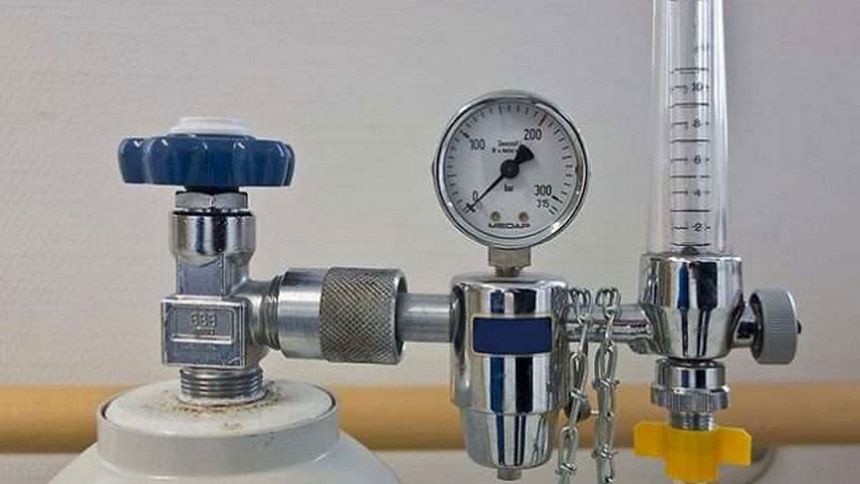India Halting Supply: Oxygen crunch may turn grave

The sudden halt to oxygen import from India amid the second Covid-19 wave may put Bangladesh in a precarious position if the current coronavirus situation deteriorates, fear health officials and suppliers.
Facing an acute shortage of oxygen due to a record rise in virus infections, India imposed a ban on supply of industrial oxygen from April 22 to cope with its huge demand.
Bangladesh used to meet 15-20 percent of its monthly requirement of around 5,400 tonnes of both medical and industrial oxygen through import from India.
Oxygen suppliers in the country said they are still managing the supply chain for public and private hospitals by switching their production to medical oxygen from industrial one.
Meanwhile, the government has banned the use of oxygen for industrial purposes to ensure smooth supply of oxygen at hospitals.
In a circular issued on April 23, the department of explosives said hospitals and clinics are not getting oxygen for critically ill Covid patients as per their demands. Amid this situation, the use of oxygen for industrial purposes will remain suspended.
A number of Oxygen suppliers told this newspaper yesterday that a week ago when the country was seeing a spike in infections, the ratio between medical and industrial oxygen supply was 80:20. Now, the companies in the country are producing oxygen only for medical purposes.
The good news is that the infection rate is now on a downward trend, they said.
But they warned that if the current Covid situation deteriorates to something close to what India is facing now, the existing capacity will be too little to meet the demand.
India is now seeing around 3.5 lakh Covid infections every day.
Following a severe shortage of oxygen in India, the import of oxygen has ground to a halt and no tanker carrying oxygen entered Bangladesh for the last four days.
The last time an oxygen tanker was unloaded at Benapole land port was on April 22, said Biswajit Das, a representative of the Indian Exporters Association.
Five companies, including Linde Bangladesh, Spectra Oxygen Ltd and Islam Oxygen Ltd, import oxygen from India through the land port, said sources at the port.
Contacted, Mustafizur Rahman, deputy commissioner at Benapole Customs House, said 1,815 tonnes of oxygen were imported in 29 tankers from India through Benapole port from April 1 to 22.
According to customs sources, about 30,000 tonnes of oxygen were imported through the Benapole port alone in the last one year.
Officials at the Directorate General of Health Services (DGHS) said around 160 tonnes of oxygen are now required every day to ensure uninterrupted supply at public and private hospitals.
The companies in the country produce 140 tonnes of medical oxygen and the rest is imported from India. Now that India has slapped a ban on oxygen export, these companies are now producing only medical oxygen to fill the gap, they mentioned.
Linde Bangladesh Ltd, a multinational company, supplies 90 percent of oxygen at public hospitals, while the rest comes from Spectra Oxygen Ltd, they said.
Talking to The Daily Star, Saiqa Mazed, spokesperson for Linde Bangladesh, said, "Oxygen import from India has halted suddenly. To meet the demand, we have stopped producing industrial oxygen and now dedicated all our production for medical purposes," she said.
Over the last six weeks, the demand for medical oxygen at Covid hospitals almost doubled. But now the Covid situation is improving, easing a bit the pressure on medical oxygen supply, mentioned Saiqa.
"So far, we have met the demand under a strain. It's still manageable. But if the situation deteriorates in the coming days and if the Indian ban continues for a long period, we are not sure how long we will be able to meet the demand.
"We don't have the capacity to increase production. We have already reached our maximum production capacity."
Asked whether they are looking for alternative sources to import oxygen, Saiqa said importing oxygen from India is cost-effective and less time-consuming as it can be transported by road.
"But if we now look to import it from other countries such as Singapore, the cost will surely increase, so is the time. Oxygen should be imported under a government-to-government arrangement like the Indian government is doing now. Linde can coordinate and support the government with logistics and expertise," she said.
Linde has two oxygen plants in Narayanganj and Chattogram which produce 90 tonnes oxygen a day. They provide oxygen to all government hospitals and some of the largest private hospitals in Bangladesh which need uninterrupted oxygen supply at the intensive care units (ICUs).
The Linde official said they have sought support from the authorities concerned for getting uninterrupted supply of electricity and gas for seamless operations of its two plants.
Talking to this newspaper, Mustain Billah, chief executive officer at Islam Oxygen Ltd, said they used to import 30 tonnes of oxygen from India per week.
He further said they stopped producing industrial oxygen 25 days ago and are now producing medical oxygen only.
"We produce 28,000 cubic metres [28 tonnes] of oxygen per day. The entire production capacity is now dedicated to medical oxygen," he said, adding that the recent fall in infection rate has eased the pressure.
Seeking anonymity, an official at Spectra Oxygen Ltd said they used to import 20 tonnes of medical oxygen from India a week.
Farid Hossain Miah, director (hospitals and clinics) at the DGHS, said, "We used to meet 15-20 percent of the demand for medical oxygen through import from India… We are still not facing problems as the Covid situation is improving and the suppliers have stopped providing oxygen to industries.
"But if there is a sharp rise in the number of Covid patients again, we may face problems."
Asked, what could be the alternatives if the situation turns bad, the DGHS director said they are thinking about engaging local companies in medical oxygen production.
Supply of medical oxygen to public hospitals has been under a strain as the demand for the life-sustaining gas doubled in the last few weeks.
With the second wave being much stronger than the first one, more and more patients are in need of oxygen support as the highly transmissible virus infects lungs severely, causing serious breathing problems among many, said doctors at public hospitals in the capital.
Uninterrupted oxygen supply is very crucial in saving lives of critical coronavirus patients. Most patients are coming with severe shortness of breath and need oxygen via a high-flow nasal cannula, they pointed out.


 For all latest news, follow The Daily Star's Google News channel.
For all latest news, follow The Daily Star's Google News channel. 



Comments